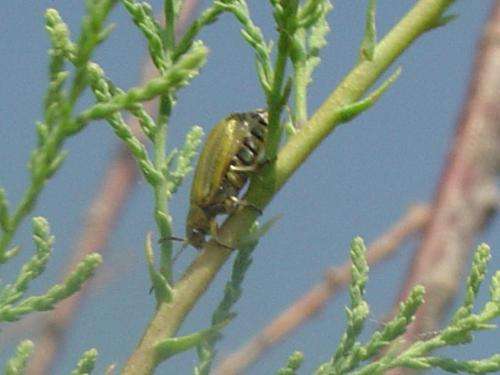There's a new bug in town

There's a new bug in town, but entomologists stress its arrival is good news for El Paso residents and the environment.
Subtropical tamarisk beetles, better known as saltcedar leaf beetles, have made their way to El Paso after first being released along West Texas waterways in 2006 to combat saltcedar, said Dr. Salvador Vitanza, Texas A&M AgriLife Extension Service entomologist in El Paso County.
Saltcedar thickets compete for water, increase flooding and reduce biodiversity, said Dr. Allen Knutson, AgriLife Extension entomologist at Dallas. He said saltcedar was first introduced as an ornamental plant in the early 1800s but escaped and has become a serious invasive species.
"We've been working with the U.S. Department of Agriculture-Agricultural Research Service and other agencies to establish the leaf beetles for biological control of saltcedar," Knutson said. "We're now starting to see an area-wide impact as beetles defoliate miles of saltcedar thickets along the Rio Grande and Pecos Rivers and in the Texas Panhandle and Rolling Plains."
Vitanza recently surveyed the westward movement of the beetles and found abundant larvae along the Texas/Mexico border south of Tornillo. He also found a few adult beetles two miles south of Fabens and 1.5 miles east of Clint.
"These beetles have been known to spread up to 80 miles in a season in ideal conditions," Vitanza said. "Currently, a few adult beetles have been observed defoliating saltcedar plants near Clint. It's possible some beetles may reach the city of El Paso before the year is over.
"Gerardo Tarin Torres, the department head of Mexico's Integrated Management of Contaminants in Chihuahua, reportedly found the beetle at Instituto Campestre in Ciudad Juarez on July 20 which is the first time they've been spotted in that city."
The control of saltcedar using the beetles is one of the most successful examples of biological control of noxious plant species in the U.S., according to Vitanza, who said the beetles are host-specific and safe around anything that's not a saltcedar or Athel tree, which belongs to the same plant genus as saltcedar.
"You can rest assured that the saltcedar leaf beetle will not damage any plant species other than saltcedar and Athel, both in the genus Tamarix," he said. "The beetles will not hurt people or pets or attack other insects. Generally, when they run out of saltcedar to eat, they simply starve to death."
The one exception is athel, said James Tracy, a graduate research assistant in Texas A&M University's department of entomology.
Tracy said there have been some isolated instances in the El Paso Valley of the beetles eating Athel, an ornamental tree which is a close relative of saltcedar, but the browning of the leaves is only temporary.
"The athel trees are not dead, but should resprout new leaves in a month or so," he said. Saltcedar beetles prefer saltcedar over athel, so damage to athel usually only occurs when beetle numbers are high. Defoliation of athel should be less once the larger beetle populations move upriver."
Dr. Mark Muegge, AgriLife Extension entomologist at Fort Stockton, said homeowners who want to save athel or even saltcedar trees in their landscape can protect the trees from the beetles by treating them with insecticide. For more information, see today.agrilife.org/2010/08/27/saltcedar_beetle/.
"Attacked trees turn brown as larvae consume leaves and girdle small branches," Knutson said. "Control of saltcedar occurs only after repeated defoliations, which weaken the trees, and they eventually die due to starvation, followed shortly by the beetle, once their food supply is exhausted."
For more information about salt cedar control see:
bc4weeds.tamu.edu/
insects.tamu.edu/feature/saltcedar_program
twri.tamu.edu/publications/con … t/saltcedar-beetles/
Provided by Texas A&M University



















